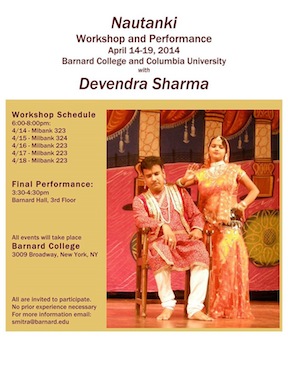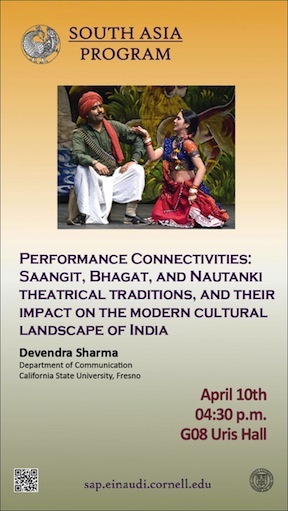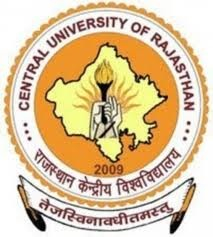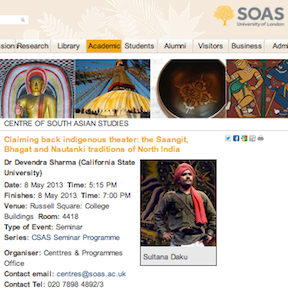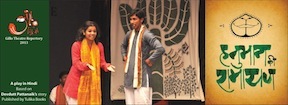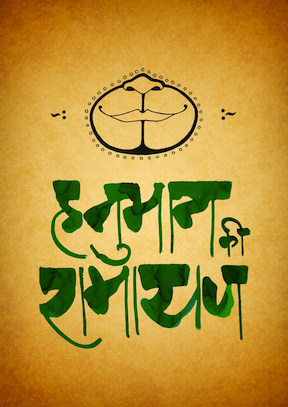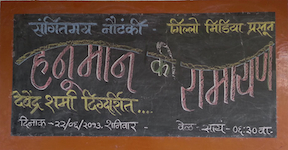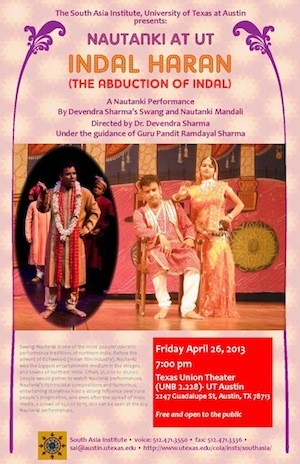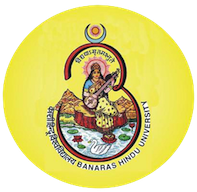The Architectonics of a Nautanki Performance
Nautanki performances can take place in any open space available in or around a village that can accommodate audiences in hundreds or thousands. Sometimes this space is made available by the village chaupal1; other times the playground of the local school becomes the performance site. A Nautanki stage is elevated above the ground and is made up of wooden cots (usually provided by local villagers). Other times a chabutara2 in front of a house can serve as stage. The stage is open on three sides. There is a backdrop on the fourth side, usually made of a colorful cloth. Behind the stage is a temporary enclosure that serves as a make-up/changing room. Audiences sit on all the three sides of the stage. Usually children sit immediately near the stage. Male adults sit behind them. If the performance is overflowing, youngsters often climb the surrounding trees to get a birds-eye view. Women audiences sit together, physically separate from their male counterparts. Social norms dictate that newly-wed daughter-in-laws should not mingle in public, so many of them watch the performance from the rooftops of their homes.
On the stage, musicians and percussionists sit on one side and actor-singers occupy the center-stage. Harmonium, Nakkara, and Dholak are the main musical instruments that are used in Nautankiperformances. Sometimes a clarinet might be employed. There is often a person in the back corner of the stage who acts as a prompter, helping performers to remember the next line of the piece they are singing. Nautankiscenes are written in a way that there are usually only two to three performers on the stage at one time. The pleasure of Nautankilies in the intense melodic exchanges between the two or three performers; chorus is usually avoided.

A spatial depiction of a typical Nautanki performance
Image credit: Devendra Sharma
Traditional Nautankis usually start late at night, often around 10 p.m. or so, and go all night until sunrise the next morning. Nautankiperformances start with a collective Vandana3. After the Vandana, performers sing individual Bhents4. In addition to serving a spiritual and auspicious purpose, the Vandana and Bhents help Nautanki performers to warm up and to gauge their voice before the actual performance begins. After Bhents, the actual performance starts, which is usually an opera based on a popular folk theme derived from romantic tales, mythology, or biographies of local heroes. The performance is often punctuated with individual songs, dances, and skits, which serve as breaks and comic relief for audiences. Audiences sometimes also use these breaks to go to the toilet or pick up food from their homes or nearby shops. There is no intermission in Nautanki performances. As the sun rises, performers and audiences collectively shout a slogan to praise the local deity of the area to mark the end of the performance. For instance, in and around Mathura region, Nautanki performances end with the following slogan: Bol Giriraj Maharaj Ki Jai (Holy Giriraj [the local deity] be praised).
However, new Nautanki performances, centering around social messages about health, women’s empowerment, dowry, and family planning, usually happen during the day or in the early evening. Many pro-social performances happen as a part of local health fairs or other cultural events. They are also of a much shorter duration—around 2 hours. This is to give audiences an opportunity to watch performances during a break in their daily routine.
- 1A central place in the village where villagers meet to discuss local issues and for leisure
- 2A permanently constructed platform in front of a traditional village house where elders of the house can chat with visitors before they enter the house
- 3A devotional chorus that is sung by the performers to please the gods so that their performance is a success
- 4A devotional Nautanki song

